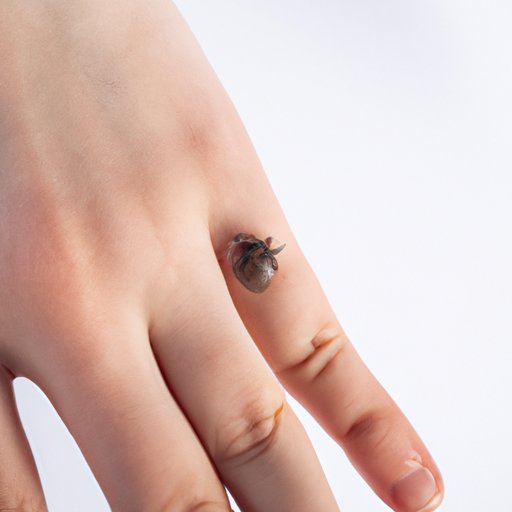
Introduction
Do you enjoy the great outdoors? Camping, hiking, and picnicking are all fantastic ways to spend time in nature. However, one small, barely visible creature can ruin the fun: ticks. Not only are they blood-sucking parasites, but they may also carry Lyme disease, which can cause severe health problems. In this article, we’ll explore the different types of ticks that cause Lyme disease, ways to protect yourself from their bites and how to recognize the early signs of Lyme disease.
Lurking in the Tall Grass: A Comprehensive Guide to Understanding Lyme Disease-Causing Ticks
Ticks are tiny parasites that are similar in appearance to spiders. There are more than 900 species of ticks worldwide, but not all of them carry Lyme disease. The two most common ticks that can cause Lyme disease are the blacklegged tick (also called the deer tick) and the western blacklegged tick (found on the West Coast of the United States). These ticks are typically smaller than the common dog tick and can be difficult to see. They have eight legs, and their body position changes from flat to round when they feed on a host.
Ticks live in tall grass, brush, and wooded areas. They attach themselves to animals or humans to feed on their blood. The tick’s life cycle includes four stages: egg, larva, nymph, and adult. During these stages, the tick feeds on different animals, including mice and deer, which can transmit the bacteria that cause Lyme disease.
Bite-Size Danger: The Connection between Ticks and Lyme Disease
Lyme disease is a prevalent illness in the United States, particularly in the Northeast, Midwest, and West Coast. According to the Centers for Disease Control and Prevention (CDC), approximately 300,000 people are diagnosed with Lyme disease every year in the US. Ticks are responsible for transmitting the bacteria Borrelia burgdorferi, which causes Lyme disease, to humans.
When a tick bites you, it attaches itself to your skin and feeds on your blood. During the feeding process, the tick may transmit the bacteria to your bloodstream. Additionally, certain activities increase your risk of acquiring Lyme disease, such as hiking, camping, working outdoors, and having pets that may carry infected ticks.
What You Need to Know About Ticks and Lyme Disease this Summer
Preventing tick bites is an essential part of protecting yourself and your loved ones from Lyme disease. Wear light-colored clothing, long-sleeved shirts, and pants. Use insect repellents that contain at least 20% DEET on exposed skin and clothing. Avoid brushing against bushes and tall grasses. When you come inside, it’s crucial to check yourself and your pets for ticks. Check your scalp, armpits, groin, and clothing.
Early diagnosis and treatment of Lyme disease are critical to prevent complications of the illness. The early signs of Lyme disease include flu-like symptoms, such as fatigue, fever, headache, and muscle aches. The characteristic bull’s eye rash is present in approximately 70-80% of cases. Seek prompt medical attention if you suspect exposure to ticks and exhibit any of these symptoms.
Outsmarting the Tiny Parasites: How to Protect Yourself from Lyme Disease
You can limit the presence of ticks in your yard by keeping your grass mowed low and raking debris, such as leaves and twigs. Move woodpiles and bird feeders away from your house. It’s vital to inspect your home and pets for ticks. If you have tick-infested areas at home, take measures to address the issue, such as clearing leaf litter and cutting back brush.
If you find a tick on your body, remove it using fine-tipped tweezers. Grasp the tick close to the skin’s surface and pull upward with steady, even pressure to remove the tick entirely. Don’t twist, jerk, or squeeze the tick, or you may increase the risk of infection.
A Closer Look at the Ticks That Cause Lyme Disease and How to Avoid Them
The most common ticks that spread Lyme disease include black-legged ticks and Western black-legged ticks. Each stage of the tick’s life cycle feeds on different-sized animals, so they are most likely to attach themselves to humans in the nymph stage, which typically occurs in the spring and summer. Ticks are typically found in wooded and grassy areas, so it’s essential to use caution when hiking, camping, or engaging in outdoor activities.
To avoid tick bites, stay on marked trails when hiking, and avoid tall weeds and vegetation. Keep dogs on leashes and check them for ticks after spending time outside. Dispose of vegetation, such as brush piles and leaf litter, that could harbor ticks. Prevention is the key to protecting yourself from Lyme disease.
The Hidden Dangers of Tick Season: An Overview of Lyme Disease-Carrying Ticks
Lyme disease can cause severe health problems, such as heart palpitations, facial palsy, and arthritis. In rare cases, it can lead to severe, long-term complications. Early diagnosis and treatment can prevent complications from developing.
If you suspect you’ve been bitten by a tick or have symptoms of Lyme disease, seek prompt medical attention. Treatment usually involves antibiotics, and most people recover fully within a few weeks. However, some people may experience fatigue, joint pain, or neurological problems for months or even years after treatment.
Conclusion
Lyme disease is a growing health problem in many areas. It’s essential to take precautions to avoid tick bites and recognize the early symptoms of Lyme disease. By following safety measures and taking steps to limit the presence of ticks, you can protect yourself and your loved ones from the dangers of Lyme disease. Don’t hesitate to seek medical attention if you suspect you’ve been bitten by a tick or exhibit any symptoms of Lyme disease.





